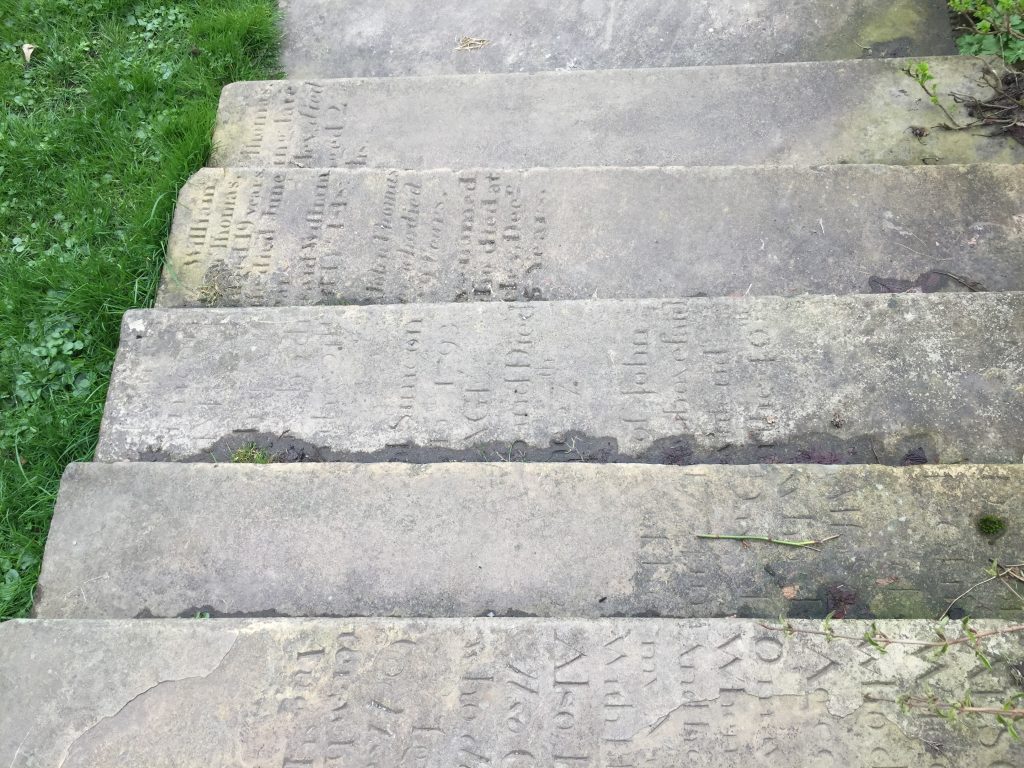1374 The Black Death (bubonic plague) killed
about 40% of people in Luddenden.
1600s Luddenden Valley was one of the
richest places in the country, as yeoman
clothiers sold textiles all over this country and
exported to Europe. They built some of the
finest houses in the Luddenden area during
this time.
https://www.calderdale.gov.uk/v2/sites/default/files/luddenden-appraisal.pdf

Well, I’m glad it’s not Big Foot nursery!
Kershaw Hall was built by James Murgatroyd, who later left the house to his son Thomas Murgatroyd. It was Thomas who renovated much of the property and whose initials, along with those of his wife Anna Murgatroyd, can be seen engraved over the principal entrance. It is assumed that these renovations were completed around 1650, as this is the date that is engraved upon the archway leading to the courtyard.
Thomas and Ann’s initials above the main entrance. 
Oh, lovely. A bin with a date! 
Steps made from gravestones at St Mary’s church, Luddenden. It was Palm Sunday and I was surprised to see that the church was open. I chatted to someone there and took a palm cross, reminding me of my when Turton church used to distribute these on Palm Sunday 
Too many gravestones to lie them flat 
I followed the path behind the church, following Luddenden Beck and found these lovely flowers on the wall above the stream 
1847 John Murgatroyd built first mill at Oats
Royd. During the next 40 years, more sheds to
house different processes were built, such that by
1890, it was one of the largest worsted
manufacturers in the West Riding.
Love these steps worn by clogs of the textile workers 
Then I found a wonderful allotment constructed in the remains of a ruined mill. 
Mill ruins 
What a work of art Nature has produced here 
I walked around the perimeter fence of the allotment, which also housed chickens and geese. Here is the Bug Hotel 
Anyone home? 
How inviting 
I marvelled at the beauty someone has created here . . . . 
. . . . .and all the little lovely touches. 
What lovely colours 
And then the creator of this wonderful place came along and invited me into his haven. 
Sam is a dry stone waller by profession and has been working on this allotment and buildings for 20 years. He repaints them every year. 
I admired the chickens and said hello to the geese and Sam gave me half a dozen newly laid eggs to take home! 
Sam’s woodpile. He has several fire pits which he uses throughout the winter. 
The subscription library attached to the Lord
Nelson Inn operated from 1776 and presumably was patronised by people who had
had some education.
The present building is dated 1634 GCP
(Gregory Patchett). It is constructed of rendered stone,
with a stone slate roof and an L-shaped plan with rear
wing. It is particularly of note because of its association with Branwell Bronte, who used to frequent it when working as a booking clerk at Luddendenfoot station, because of the very early library there, which existed from 1776 until 1917.

Leave a Reply